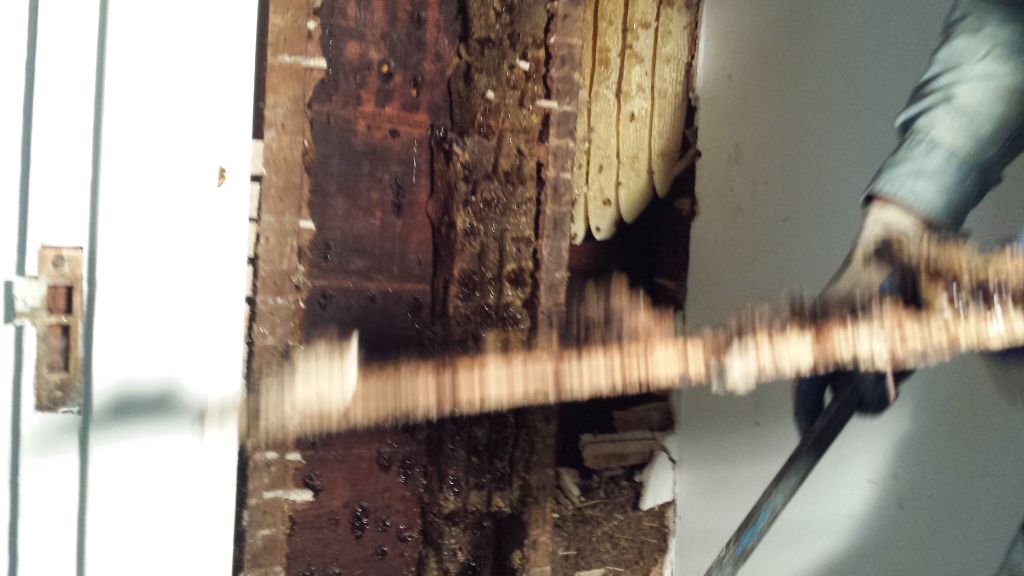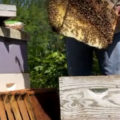On Sunday, myself and two others executed a honey bee colony cut-out that has been in the planning for a couple of weeks. The colony was in a historical home on Cincinnati’s west side. The home owners said the bees have been in there for as long as they can remember and the mailman told them he’s watched bees come in and out since the 70’s. Sure, the colony has probably ebbed and flowed and maybe even went vacant for a stint… but where there is easy access to a dry space that smells of bees, and has plenty of comb in the walls, more bees are sure to eventually move in.
Behind plaster and lathe, and in 12 foot uninsulated wall cavities, we eventually found a colossal colony that took 5 hours to remove. The home owners lived with the bees… that found their way in to the house but flew towards the light of the nearest window… which was the beautiful stained-glass window you see in the pics. The bees stayed near the window until they eventually died and cleaning up dead bees under the window became a daily task for them. They were apparently willing to live with the bees for quite a bit of time (which was really cool of them) but after the birth of their child, they decided it was a problem that needed to be dealt with. They spoke to many beekeepers before us and no one was interested in getting them out since it was going to be nothing short of a messy job.
We decided to go over and take a look. Using a stethoscope on the walls inside, we were able to identify a wall in a closet on the other side of the wall that we could enter to access the bees. What we didn’t know that we were about to uncover an entire wall of bees. We ran through the options with the home owners, explaining that a trap-out was possible, but it was a lengthy process, and in the end, all the comb and honey is left in the wall. All holes would need to be sealed so that future bees wouldn’t find their way in. In retrospect, we now know there would be over 100 pounds of honey left sitting in the wall… something everything from ants and roaches, to mice would find.
After identifying where we would enter, we got to work. We tapped a hold through the lath, and were happy to confirm we hit the right spot as a few bees emerged. We blew a little smoke into the holes we found outside to calm them as we cut a square access hole inside. We use a bee vac that can safely vacuum bees into a special box that collects them. We cut a little more, and vac’d a little more. The combs just wouldn’t stop. We cut down to the floor the width of three studs, then we went upwards. The ceilings were about 12 feet high… and we ended up cutting all the way up. We gently vac’d bees, and cut out the brood frames first. These are the frames that hold eggs, and young larva that will grow in to adult bees. The brood frames are puzzle-pieced in to frames and rubber bands are used to hold the combs in. We’re in effect, rebuilding the bee combs in a standard bee box so that we can remove and inspect the frames later as the colony is managed. Of all the comb in the wall, we were able to build about 4-5 brood frames (many with pollen and nectar stores as well)… but all the rest was capped honey comb that broke our heart to have to tear out. We asked the home owner if they wanted to new comb to eat and use. They did, so we laid the best stuff on a plate for them to take to the kitchen. The rest was oozing out from removing the plaster lathe from it. Rather then waste all the honey, we put those combs in plastic garbage bags to take back to the apiary and lay them out on sheets for the bees to come rob out.
In the end, we took home a very nice colony of bees, all the honey comb that became free bee food, and we left some very happy home owners who were thankful the bees have finally been properly removed, safely, effectively, and free of charge. They went out-of-the-way to thank us and tell us we did them a huge favor. For us, it’s just another fun day playing with the bees. We’re happy to help someone out especially if we can help save the bees. We also gave the colony to a new beekeeper in our group who needed them. It’s nice to help a new beekeeper get a hive set up with little to no cost as well.
Enjoy some pictures and videos below… and if you need help with bees in the Midwest, drop me a line.

















Leave a Reply